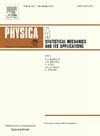基于蜂窝自动机模型的车道管理措施下混合交通流特性分析
IF 2.8
3区 物理与天体物理
Q2 PHYSICS, MULTIDISCIPLINARY
Physica A: Statistical Mechanics and its Applications
Pub Date : 2024-10-16
DOI:10.1016/j.physa.2024.130177
引用次数: 0
摘要
未来,由人类驾驶车辆(HDV)、互联和自动驾驶车辆(CAV)以及 CAV 排组成的混合交通流将长期并存。探索不同车道管理措施下混合交通流的运行特性对于有效管理和控制至关重要。首先,我们分析了 HDV、CAV 和 CAV 排的运动特征,并确定了混合交通流中的跟车类型。根据车辆运动特征和 HDV 驾驶员的最大期望速度差异,我们利用安全距离模型建立了 HDV 的纵向运动规则。对于 CAV 及其车队,我们通过考虑车队合并和分流行为以及车队驾驶的速度和间距误差要求来制定纵向运动规则。随后,我们在对称双车道蜂窝自动机(STCA)模型的基础上制定了横向变道规则,并考虑了 HDV 和 CAV 之间反应时间和跟车距离的差异。最后,我们利用多车道混合交通流蜂窝自动机模型在单向三车道高速公路上进行了仿真实验,分析了混合车道、CAV专用车道和CAV优先车道等不同车道管理措施下的混合交通特征。结果表明,随着 CAV 比例(用 p 表示)的增加,交通流容量、最优密度和拥堵密度也随之增加。当 p≤0.6 时,k-q 图呈三角形,而当 p>0.6 时,则呈梯形。实施 CAV 专用车道可降低协同自适应巡航控制(CACC)的衰减率,但只能在 CAV 比例达到一定阈值时提高交通流容量。与混合车道方案相比,当 p≤0.3 和 k≤0.3 时,CAV 优先车道方案不仅能满足交通需求,还能降低 CACC 退化率。CAV 优先车道的车速超过 HDV 车道,有利于提高 CAV 的交通效率。高清车驾驶员的最高车速分布会影响混合交通流的基本图示和 CAV 优先车道的性能,随着高清车最高车速标准偏差的增加,影响会更大。本文章由计算机程序翻译,如有差异,请以英文原文为准。
Analysis of mixed traffic flow characteristics based on cellular automata model under lane management measures
In the future, mixed traffic flow comprising Human-Driven Vehicles (HDVs), Connected and Autonomous Vehicles (CAVs), and CAV platoons will coexist for an extended period. Exploring the operational characteristics of mixed traffic flow under different lane management measures is essential for effective management and control. Initially, we analyze the motion characteristics of HDVs, CAVs, and CAV platoons and identify the car-following types within mixed traffic. Based on vehicle motion characteristics and the variance in maximum desired speeds among HDV drivers, we establish longitudinal motion rules for HDVs using a safety distance model. For CAVs and their platoons, we develop longitudinal motion rules by considering platoon merging and splitting behaviors, as well as speed and spacing error requirements for platoon driving. Subsequently, we formulate lateral lane-change rules based on the Symmetric Two-lane Cellular Automata (STCA) model, considering differences in reaction times and following distances between HDVs and CAVs. Finally, we conducted simulation experiments on a unidirectional three-lane highway using the multi-lane mixed traffic flow cellular automata model, analyzing the characteristics of mixed traffic under various lane management measures, such as mixed lane, CAV-dedicated lane, and CAV-priority lane. The results show that as the proportion of CAV (denoted as p) increases, the traffic flow capacity, optimal density, and jam density also increase. When p≤0.6, the k−q diagram exhibits a triangular shape, whereas for p>0.6, it assumes a trapezoidal shape. Implementing CAV-dedicated lane can reduce Cooperative Adaptive Cruise Control (CACC) degradation rates but only enhances traffic flow capacity when the CAV proportion reaches a certain threshold. Compared to the mixed lane scheme, when p≤0.3 and k≤0.3, the CAV-priority lane schemes not only meet traffic demands but also reduce CACC degradation rates. The vehicle speed in CAV-priority lane surpasses that in HDV lanes, facilitating improved traffic efficiency for CAVs. The distribution of maximum speeds among HDV drivers affects the fundamental diagram of mixed traffic flow and the performance of CAV-priority lane, with greater impacts observed as the standard deviation of the HDVs' maximum speed increases.
求助全文
通过发布文献求助,成功后即可免费获取论文全文。
去求助
来源期刊
CiteScore
7.20
自引率
9.10%
发文量
852
审稿时长
6.6 months
期刊介绍:
Physica A: Statistical Mechanics and its Applications
Recognized by the European Physical Society
Physica A publishes research in the field of statistical mechanics and its applications.
Statistical mechanics sets out to explain the behaviour of macroscopic systems by studying the statistical properties of their microscopic constituents.
Applications of the techniques of statistical mechanics are widespread, and include: applications to physical systems such as solids, liquids and gases; applications to chemical and biological systems (colloids, interfaces, complex fluids, polymers and biopolymers, cell physics); and other interdisciplinary applications to for instance biological, economical and sociological systems.

 求助内容:
求助内容: 应助结果提醒方式:
应助结果提醒方式:


